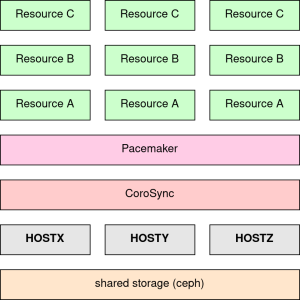Configuration
The inventory may define these hosts:
observers: Set of hosts to observe the cluster (only the first is considering)
...
Hypervisors: Set of machines to hosts VMs.
| Info |
|---|
Remember that the cluster must contains an odd number of machines. For example three hypervisors or one observer and two hypervisors. |
Node redundancy
All nodes in the cluster have an access to a shared storage via ceph (see Shared storage section). With it, the cluster is in N to N redundancy mode.
- Corosync will provides messaging and membership services.
- Pacemaker will manage the cluster (synchronize resources between each node).
More details on pacemaker here and corosync here.
...
Management tool
The vm_manager project is an high-level interface of pacemaker and ceph to manage the VM like a resource. He is installed during the installation step and provides the vm-mgr command.
Sub-command
All sub-commands has -n, --name required option to specify which resource should be used.
add_colocation: Adds a colocation constraints between resourcesclone: Creates a copy of the VMcreate: Generates a new resource from a VMcreate_snapshot: Creates a snapshot of a resourcedisable: Stops and removes the resource on the clusterenable: Adds and starts the resource on the clusterget_metadata: Gets a metadata of a resourcelist: Lists all resourceslist_metadata: Lists all keys of a resourcelist_snapshots: Lists all created snapshotspurge: Deletes all snapshots of a resourceremove: Removes the resourceremove_snapshot: Removes a snapshot of a resourcerollback: Rollbacks to a snapshot for a resourceset_metadata: Sets a metadata of a resourcestart: Start a resourcestatus: Gets the status of a resourcestop: Stops a resource
Resources status
Undefined:Disabled:Failed:Started:Starting:Stopping:Stopped:
Manage VM
Add VM in the cluster:
Check the execution of the resource:Code Block language bash vm-mgr create --name NAME --xml /path/to/configuration.xml --image /path/to/disk.qcow2 --disable --force --enable-live-migration --migration-user virtu --migration-to-timeout 180Code Block language bash crm statusGet the status of the resource:
Code Block language bash vm-mgr status --name NAMEDelete VM in the cluster:
Code Block language bash m-mgr remove --name NAME
...
Replace a dead node
The ansible/playbooks/replace_machine_remove_machine_from_cluster.yaml playbook can remove a node in the cluster. For this, the machine_to_remove should be set to the hostname to remove.
The below command should be launch in the ansible project.
| Code Block | ||
|---|---|---|
| ||
cqfd run ansible-playbook -i /path/to/inventory.yaml -e machine_to_remove=HOSTNAME playbooks/replace_machine_remove_machine_from_cluster.yaml |
...
